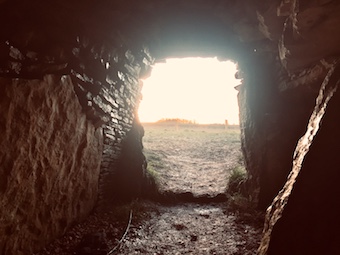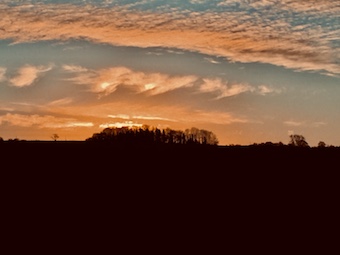
We left the house on Christmas morning as the first crack of light was spreading in the east. Down empty roads and muddy lanes running with water, to a little parking space where the puddles were iced over. The first time this year I’d pulled on hat, scarf, thick gloves, thermals and padded winter coat.
Across a racing stream on a footbridge slippery with frost, and up a frozen grass slope to the long barrow darkly silhouetted on the skyline against a sky already broadened into a peach coloured dawn, the blue above streaked with dozens of drifting horsetails of cloud.

I wormed my way into the cold, damp stone passage that led back for 30 feet or so into the artificial hillock of the barrow. The floor where I knelt was wet and muddy, the stones hard against my back. At the entrance a big ammonite embedded in one of the kerbstones. Looking out, the view was south-east up a gentle slope to a wood on the skyline.
It was a half-hour wait, with the invisible sun lighting up the higher features of the village in the valley, church tower and fine tall buildings, the golden light gradually creeping down the slope behind the houses, and crowds of rooks becoming agitated and vocal at the sunrise they could already see from their vantage points fifty feet in the air.

At last the moment came as the first shallow arc of the sun rimmed the hill, spinning like a ball, its intense light diffused behind the ivy-thickened skeletons of the trees. The clouds gleamed, the peachiness of the sky leached into pale blue, and a finger of dazzling sunlight approached down the sloping field, entered the passage, and lit up the back wall of the burial chamber in an unbroken wash of light as bright as polished silver, as it has done at every winter solstice since the architects of the barrow aligned it so precisely 5,000 years ago.